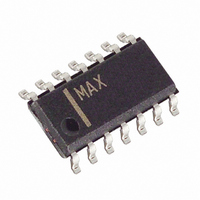MAX3292ESD+ Maxim Integrated Products, MAX3292ESD+ Datasheet - Page 10

MAX3292ESD+
Manufacturer Part Number
MAX3292ESD+
Description
IC TXRX RS485/422 10MBPS 14-SOIC
Manufacturer
Maxim Integrated Products
Type
Transceiverr
Datasheet
1.MAX3292EPD.pdf
(16 pages)
Specifications of MAX3292ESD+
Number Of Drivers/receivers
1/1
Protocol
RS422, RS485
Voltage - Supply
4.75 V ~ 5.25 V
Mounting Type
Surface Mount
Package / Case
14-SOIC (3.9mm Width), 14-SOL
Operating Supply Voltage
5 V
Mounting Style
SMD/SMT
Product
RS-422/RS-485 Combination
Lead Free Status / RoHS Status
Lead free / RoHS Compliant
The MAX3291/MAX3292 high-speed RS-485/RS-422
transceivers feature driver preemphasis circuitry, which
extends the distance and increases the data rate of
reliable communication by reducing intersymbol inter-
ference (ISI) caused by long cables. The MAX3291 is
programmable for data rates of 5Mbps to 10Mbps,
while the MAX3292 is programmable for data rates up
to 10Mbps by using a single external resistor.
The MAX3291/MAX3292 are full-duplex devices that
operate from a single +5V supply and offer a low-cur-
rent shutdown mode that reduces supply current to
100nA. They feature driver output short-circuit current
limiting and a fail-safe receiver input that guarantees a
logic-high output if the input is open circuit. A 1/4-unit-
load receiver input impedance allows up to 128 trans-
ceivers on the bus.
Inter-symbol interference (ISI) causes significant prob-
lems for UARTs if the total RS-485/RS-422 signal jitter
becomes 10% or more of the baud period. ISI is
caused by the effect of the cable’s RC time constant on
different bit patterns. If a series of ones is transmitted,
followed by a zero, the transmission-line voltage rises
to a high value at the end of the string of ones (signal 1
in Figure 12). As the signal moves towards the zero
state, it takes longer to reach the zero-crossing,
because its starting voltage is farther from the zero
crossing. On the other hand, if the data pattern has a
string of zeros followed by a one and then another zero,
the one-to-zero transition starts from a voltage that is
much closer to the zero-crossing (V
takes much less time for the signal to reach the zero-
crossing (signal 2 in Figure 12). In other words, the
propagation delay depends upon the previous bit pat-
tern. This is inter-symbol interference (ISI).
Preemphasis reduces ISI by increasing the signal
amplitude at every transition edge for about one baud
period, counteracting the effects of the cable (see the
section Setting the Preemphasis Interval ). Figure 13
shows a typical preemphasis waveform optimized for
data rates between 5Mbps and 10Mbps. When DI
changes from a logic low to a logic high, the differential
output switches to a strong high. At the end of the pre-
emphasis interval, the strong high returns to a normal
high level. Both levels meet RS-485/RS-422 specifica-
tions, and the strong levels are typically 1.9 times larger
than the normal levels. If DI switches back to a logic
low before the end of the preemphasis interval, the dif-
ferential output switches directly from the strong high to
the strong low. Similarly, this explanation applies when
DI transitions from high to low.
RS-485/RS-422 Transceivers with Preemphasis
for High-Speed, Long-Distance Communication
10
______________________________________________________________________________________
Detailed Description
A
- V
B
= 0) and it
In general, preemphasis allows either double the dis-
tance for a fixed data rate or double the data rate for a
fixed existing cable distance over existing RS-485
transceivers that do not feature preemphasis. Figure 14
shows that the MAX3291/MAX3292 transmits approxi-
mately twice as far at the same data rate or twice as
fast at the same cable length as a conventional RS-485
transceiver without preemphasis for 10% jitter.
Figure 12. Inter-Symbol Interference among Two Data
Patterns: Signal 1 = 11111110, Signal 2 = 00000010
Figure 13. Typical Preemphasis Waveform with a 100ns
Preemphasis Interval
V
Y
- V
DI
V
Z
A
- V
SIGNAL 2
SIGNAL 1
B
0
1
Applications Information
1
Data Rate vs. Cable Length
1
0
100ns
0
0
t
ISI
BAUD PERIOD
1
0
1
2.5V/div
5V/div











